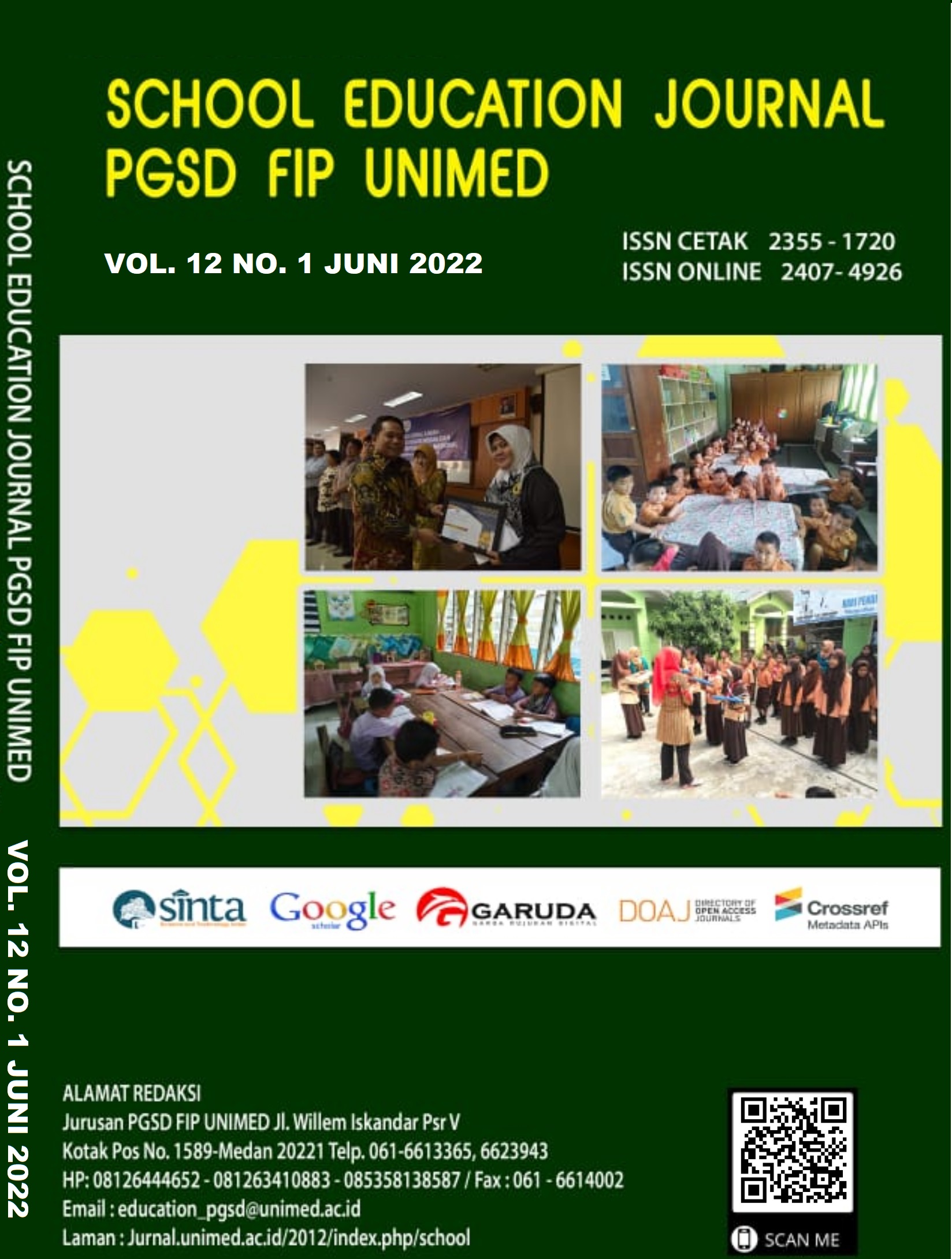MODEL PEMBELAJARAN SETS (SCIENCE, ENVIRONMENTAL, TECHNOLOGY, SOCIETY) BERBASIS BUDAYA LOKAL PADA PEMBELAJARAN IPA TERHADAP BERFIKIR KRITIS DAN PEDULI LINGKUNGAN
DOI:
https://doi.org/10.24114/sejpgsd.v12i1.34816Keywords:
SETS, Natural Science, Critical Thinking, Environmental CareAbstract
This study describes the contribution of SETS (Science, Environment, Technology, Society) model based on local culture on the improvement of creative thinking ability and environmental care of junior high school students in natural science instructional. The study was done by literature approaches by using relevant research results. By implementation of SETS model syntax with local culture enrichment, the research results showed there was the improvement of critical thinking of the junior high school student and also its environmental care in natural science learning process. Therefore, the natural science teachers were asked to implement the SETS model in natural science instruction in order to reach the learning of natural science objectives, especially in critical thinking and environmental care.References
Arwita, W. (2017). Pengembangan Model Problem Based Learning Berpola Dalihan Na Tolu untuk Mengembangkan Sikap Sosial, Kreativitas ilmiah, dan Kemampuan Kognitif Biologi Siswa di SMA Negeri Kota Tebing Tinggi Sumatera Utara, Disertasi. Program Studi Pendidikan Biologi, Pascasarjana Universitas Negeri Malang.
Binadja, A. (2002). Pembelajaran Sains Berwawasan SETS untuk Pendidikan. FMIPA Universitas Negeri Semaran.
Harahap, I. H. (2021). Pengembangan Lembar Kerja Peserta Didik (LKPD) Berbasis Keterampilan Berpikir Kritis Pada Materi Sistem Ekskresi. SEJ (School Education Journal), 11(3), 256-262.
Helmiati. (2012). Model Pembelajaran. Aswaja Pressindo.
Imaduddin, M., & Hidayah, F. F. (2019). Redesigning Laboratories for Pre-service Chemistry Teachers: From Cookbook Experiments to Inquiry-Based Science, Environment, Technology, and Society Approach. Journal of Turkish Science Education, 16(4), 489“507. https://doi.org/10.36681/tused.2020.3
Joyce, B., & Weil, M. (1980). Models of Teaching. Prentice Hall Internasional. https://doi.org/10.1007/978-981-10-2519-8_1
Khasanah, D. I. N. (2012). Penerapan Desain Sistem Pembelajaran ASSURE untuk Meningkatkan Hasil Belajar Memukul Bola dalam Permainan Kasti pada Siswa Kelas IV SD Negeri Purworejo Kecamatan Banjarsari Surakarta Tahun Pelajaran 2011/2012. Jurnal Mahasiswa Pendidikan Jasmani Kesehatan Dan Rekreasi, 1(1), 1“17.
Kusmianty, D., Widiyanto, B., & Kusuma, M. (2020). Efektivitas Model Pembelajaran Sets Metode Praktikum Pada Materi Pemanasan Global Dalam Meningkatkan Kemampuan Berpikir Kritis. Jurnal Pendidikan, 14(1), 41“51.
Lestari, I., Nurmilawati, M., & Santoso, A. M. (2015). Penerapan Problem Based Learning (PBL) untuk Meningkatkan Kemampuan Berpikir Kritis dan Sikap Sosial Peserta Didik Kelas VIII. Seminar Nasional Pendidikan Biologi, 465“471.
Lubis, M., Joebagio, H., & Pelu, M. (2019). Eksistensi Dalihan Na Tolu sebagai Kearifan Lokal dan Kontribusinya dalam Pendidikan Karakter. Intelektiva: Jurnal Ekonomi, Sosial Dan Humaniora, 193, 31-38.
Nurazizah, S., Sinaga, P., & Jauhari, A. (2017). Profil Kemampuan Kognitif dan Keterampilan Berpikir Kritis Siswa SMA pada Materi Usaha dan Energi. Jurnal Penelitian & Pengembangan Pendidikan Fisika, 3(2), 197“202. https://doi.org/10.21009/1.03211
Poedjadi, A. (2010). Sains Teknologi Masyarakat: Model Pembelajaran Kontekstual Bermuatan Nilai. Remaja Rosdakarya.
Prasetyono, R. N., & Trisnawati, E. (2018). Pengaruh Pembelajaran IPA Berbasis Empat Pilar Pendidikan terhadap Kemampuan Berpikir Kritis. JIPVA (Jurnal Pendidikan IPA Veteran), 2(2), 162“173. https://doi.org/10.31331/jipva.v2i2.679
Purnami, W., Sarwanto, S., Suranto, S., Retno, D. S., & Mauro, M. (2021). Investigation of Science Technology Ecocultural Society (STEcS) Model to Enchance Eco Critical Thinking Skills. Journal of Innovation in Education and Cultural Research, 2(2), 77“85.
Ramadani, A., A, W. J., Gunawan, M. F., & M, Y. (2021). Analysis Of Student™s Critical Thinking Skills In Terms Of Gender Using Science Teaching Materials Based On The 5e Learning Cycle Integrated With Local Wisdom. Jurnal Pendidikan IPA Indonesia, 10(2), 187“199.
Ritonga, S., Safrida, S., Huda, I., Supriatno, & Sarong, M. A. (2020). The effect of problem-based video animation instructions to improve students™ critical thinking skills. Journal of Physics: Conference Series, 1460(1). https://doi.org/10.1088/1742-6596/1460/1/012107
Sinaga, B. (2007). Pengembangan Model Pembelajaran Matematika Berdasarkan Masalah Berbasis Budaya Batak. Universitas Negeri Surabaya.
Surip, M. (2016). Berpikir Kritis Analisis Kajian Filasafat Ilmu. Halaman Moeka.
Suyanti, D. R. (2010). Strategi Pembelajaran Kimia. Graha Ilmu.
Syafriani, D. (2019). Perbedaan Hasil Belajar dan Kemampuan Berpikir Kritis Siswa yang diajar dengan Menggunakan Media Handout dan Power Point pada Materi Larutan Penyangga. SEJ (School Education Journal), 9(3), 248-256.
Sylviana, M., Kusuma, M., & Widiyanto, B. (2019). Profil Kemampuan Berpikir Kritis Siswa dengan Implementasi Model Pembelajaran SETS Berbasis Probing-Prompting. PSEJ (Pancasakti Science Education Journal), 4(2), 137“142. https://doi.org/10.24905/psej.v4i2.14
Trianto. (2011). Mendesain Model Pembelajaran Inovatif-Integratif. Kencana Prenada Media Group.
Wisudawati, Widi, A., & Sulistyowati, E. (2015). Metodologi Pembelajaran IPA. Bumi Aksara.
Yuniastuti, E. (2015). Pengaruh Model Pembelajaran SETS (Science, Environment, Technology and Society) Terhadap Hasil Belajar Biologi Siswa Kelas VII SMP Kartika V-1 Balikpapan Tahun Pelajaran 2015/2016. JST (Jurnal Sains Terapan), 1(2), 72“78. https://doi.org/10.32487/jst.v1i2.94
Zahra, M., Wati, W., & Makbuloh, D. (2019). Pembelajaran SETS (Science, Environment, Technology, Society) : Pengaruhnya Pada Keterampilan Proses Sains Sets Learning (Science, Environment , Technology , Society ): the Effect on Science Process Skills. Indonesian Journal of Science and Mathematics Education, 02(3), 320“327. https://doi.org/https://doi.org/10.24042/ijsme.v2i3.4357.
Downloads
Published
Issue
Section
License
Authors whose manuscripts are approved are approved as follows:
The publication rights for all journal manuscript materials published/published on the SEJ (School Education Journal) E-Journal site are held by the editorial board with the author's knowledge (moral rights remain with the manuscript authors).
The formal legal requirements for accessing this electronic digital journal article are subject to the terms of the Creative Commons Attribution-ShareAlike (CC BY) license, which means that E-Journal SEJ (School Education Journal) has the right to store, transfer media/format, manage in the form of a database, maintain, and publish articles without asking permission from the author as long as the author's name remains as the copyright owner.
Manuscripts published/published electronically are open access for educational, research, and library purposes.

